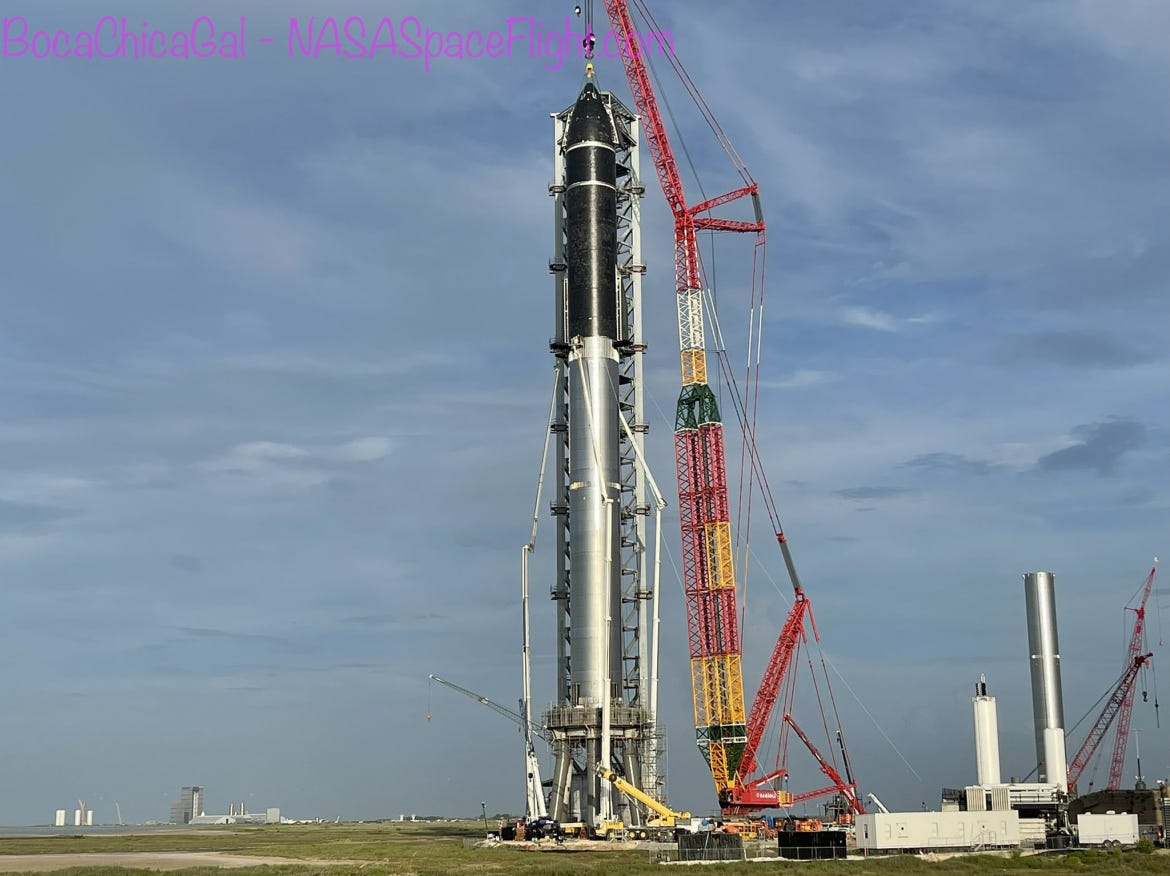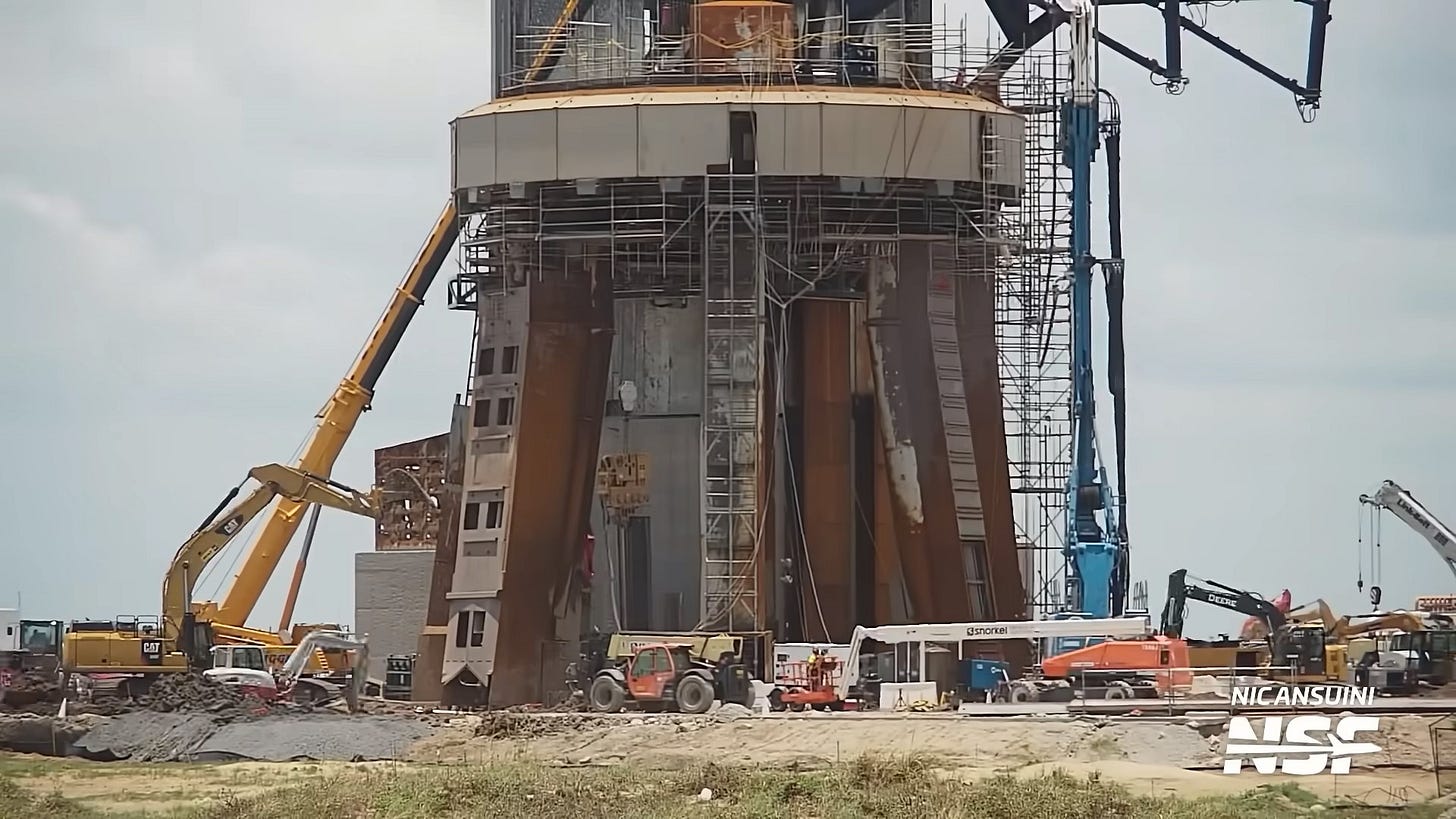In early 2021 SpaceX substantially increased the pace of Starship development work at their Starbase site in Texas.
“Starbase is moving at Warp 9” ~ Elon Musk
Hundreds of staff were moved from other SpaceX facilities, filling the adjacent Boca Chica village, trailer park and overflowing local hotels. The surge in activity this produced resulted in the long awaited assembly of the Orbital Launch Mount (aka: Stage Zero), rapid completion of the Booster 4 and Starship 20 stages, followed by the first stacking of the Starship launch vehicle on Stage Zero.
There seemed many pressing reasons to perform a surge at this time: -
Demonstrate to NASA they could complete Starship quickly, allowing a variant to be used as a Human Lander System (HLS) for moon landings
Help recruit more permanent staff at Starbase, to transition from prototyping to batch production of Starship
Subtly encourage the FAA to complete their Programmatic Environmental Assessment and issue a launch license as soon as possible
This aggressive push was expensive for the company and arduous on employees but gloriously effective. In one swoop SpaceX substantially advanced Starship development and landed a $2.9bn contract from NASA to build HLS.
Now there are signs SpaceX are preparing for a second big surge at their Starbase facility. To date they have invested £3bn in Starship development, going back to 2014, but intend to invest another $2bn this year alone on the project. In addition, Elon Musk expects another 4 or 5 Starship launches this year, including reaching orbit. While Elon is famous for setting aggressive targets, his first lieutenant (who’s normally more moderate) appears equally bullish: -
"Why can't we build a rocket every day? That's what we're focusing on with Starship, is attacking every part of the production process to be able to build lots of these machines." ~ Gwynne Shotwell/SpaceX COO
Recently Gwynne made a major coup, after she recruited Kathy Lueders to become the General Manager of Starbase. Previously Kathy was the ramrod for the Commercial Crew Program at NASA and subsequently (due to the success of SpaceX’s Crew Dragon) promoted to chief of human spaceflight, with overall responsibility for the Artemis Program and Starship HLS.
Currently SpaceX have dialed back production of Raptor engines, because they had more engines than technically needed at Starbase. This suggests production of this vital component is already prepared for the next surge, just waiting on management to pull the trigger.
"[Raptor production goal is] 2 to 4 engines per day. That’s super high volume for big rocket engines, but low volume by automotive standards.” ~ Elon Musk
Surge Rationale
Similar to 2021, there are many cogent reasons to step-up a gear at Starbase: -
NASA’s Artemis 3 mission to the moon relies on the HLS variant of Starship to perform a crew landing, hence Starship development will need to accelerate to meet the 2025 launch schedule. For example: SpaceX need to perform an uncrewed test flight of HLS to the moon in late 2024/early 2025, necessarily preceded by the launch of an orbital propellant depot and 5 or more flights of a tanker variant of Starship…
SpaceX have the next generation of Starlink satellites ready to launch on Starship, which promise to deliver ~$1tn p.a. in revenue once the constellation is complete. Likely too they will use Starship to deploy Starshield satellites, to accelerate construction of this vital surveillance and communications constellation for the US Department of Defense.
Once Starship achieves orbit, it could realistically take years to achieve full reusability, hence they will need up to 10 Starship stages per year to achieve an optimum test cadence (their current FAA license allows 5 launches per year from this site). This implies the manufacturing process at Starbase has to quickly transition from small batch to volume production, in order to fulfill the increased demand for stages.
Large scale tests at Starbase were delayed by 2 years, while the FAA completed their Programmatic Environment Review and issued a launch license, after which SpaceX managed one test flight of Starship. Currently they face further delays because of a court challenge to the FAA’s decision, although this is likely another delaying action, similar to the PEA. Assuming this legal case resolves in their favor, SpaceX will need to perform test flights as quickly as possible before the next hurdle arises.
Surge Schedule
Overall SpaceX seem to have the money available ($11.5bn revenue this year) and management aligned to accelerate work – so when can we reasonably expect the next surge to occur? Here are the main hurdles they have to overcome: -
Complete their mishap investigation into the first orbital launch, with mitigation measures agreed by the FAA. However, SpaceX are fast workers with plenty of physical evidence/telemetry to work on, hence this investigation should be complete by August.
Win the ongoing court challenge to the FAA’s Environmental Review and Starship launch license. Hopefully this will happen in the next few months, now SpaceX have lent their legal support to defend this case.
Complete repairs to the Orbital Launch Site, including installation of the new flame baffle system, then prepare a new orbital launch vehicle for flight. All being well this should be completed in the next 2 months.
“Major launchpad upgrades should be complete in about a month, then another month of rocket testing on pad, then flight 2 of Starship” ~ Elon Musk
Probably wise to note: most things take longer to complete than we imagine, which suggests the opportunity to surge could occur late-on this year.
What to Expect
Going by the enthusiasm shown by SpaceX workers for the first test flight, we could see them arrive in droves at Starbase prior for the second flight. No doubt they’ll have a humongous party in the new highbay penthouse for anyone who helped prepare the launch.
No-doubt too we’ll see a great deal more testing in and around Starbase. Their nearby Masseys site should soon be able to perform cryo tests of both Starship and its Super Heavy booster, allowing the Orbital Launch Site to concentrate on back-to-back static fires and launch operations.
Given the above we should hopefully see Starship deliver a useful payload to orbit before the end of the year. Probably some Version 2 Starlink satellites or apparatus to prove milli-g propellant transfer is possible (between separate tanks inside a single vehicle). Hopefully too we’ll see rollout of an early version HLS for ground tests – then things really get interesting!
In conclusion
SpaceX need a step evolution in their capabilities at Starbase, in order to provide adequate support for NASA, the DoD and secure their future finance. All being well they should be ready to trigger this surge in as little as 2 months, but likely before the end of the year. Seeing 5 Starship launches a year would be amazing, though just the beginning for all they have planned. Eventually SpaceX want to have 1,000 Starships in continuous operation, shuttling between Earth and Mars, in order to create a self sustaining colony. This would probably entail Starship mass production, which suggests another Starship surge on the horizon, following this one…






Great read, thanks for sharing. One error is in this part:
“SpaceX have the next generation of Starlink satellites ready to launch on Starship, which promise to deliver ~$1tn p.a. in revenue once the constellation is complete.”
The whole market is about $1tn p.a. and Musk and Shotwell have said they hope to get about 3% of that total market to get to 30 billion $ p.a.
Still a lot of money and plenty to fund a Mars colonization effort!